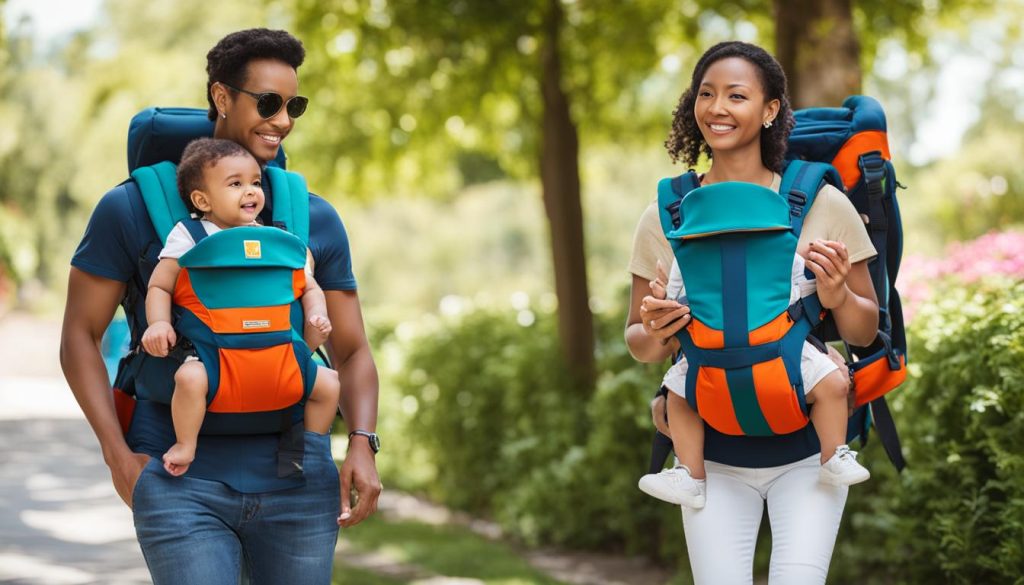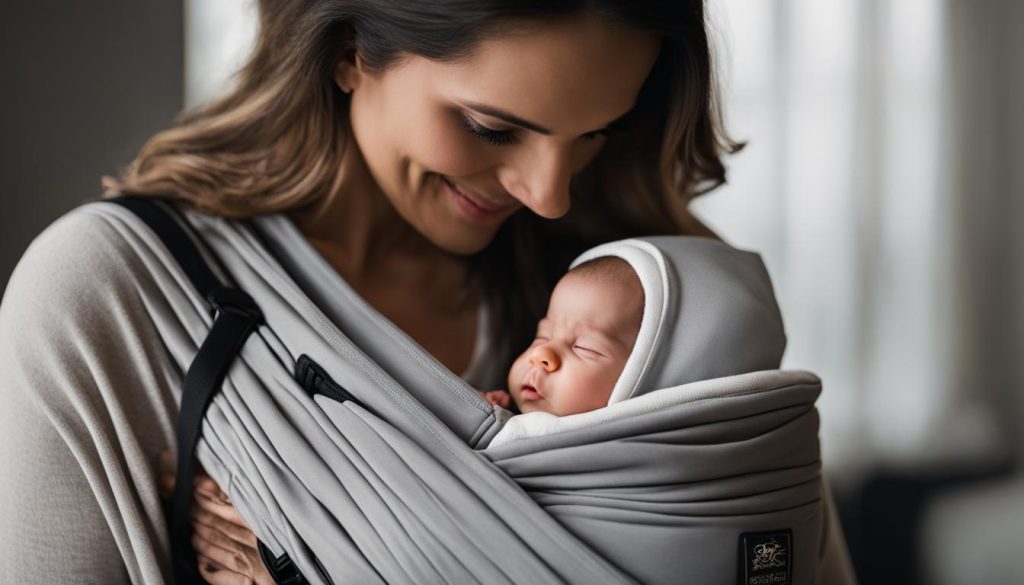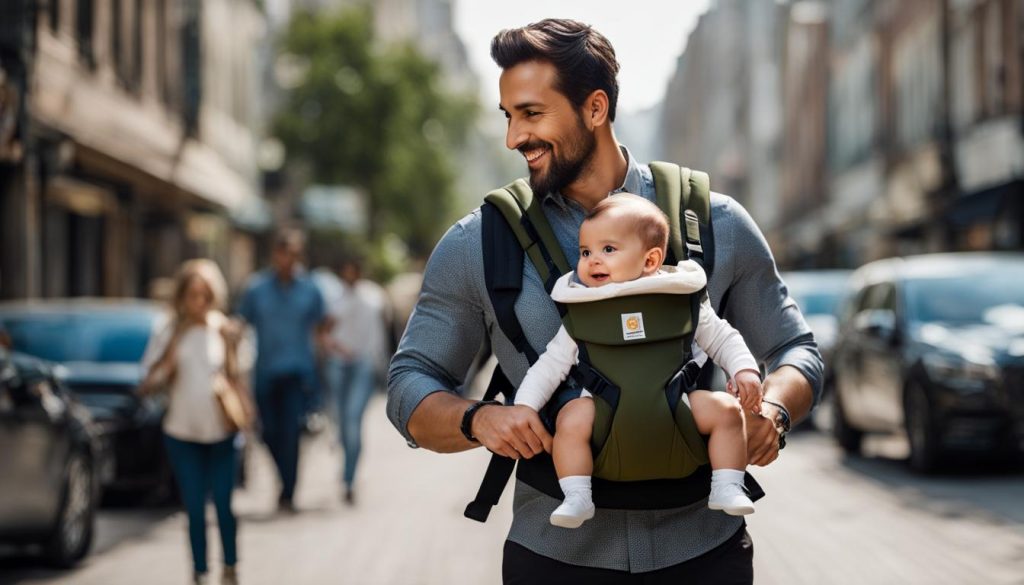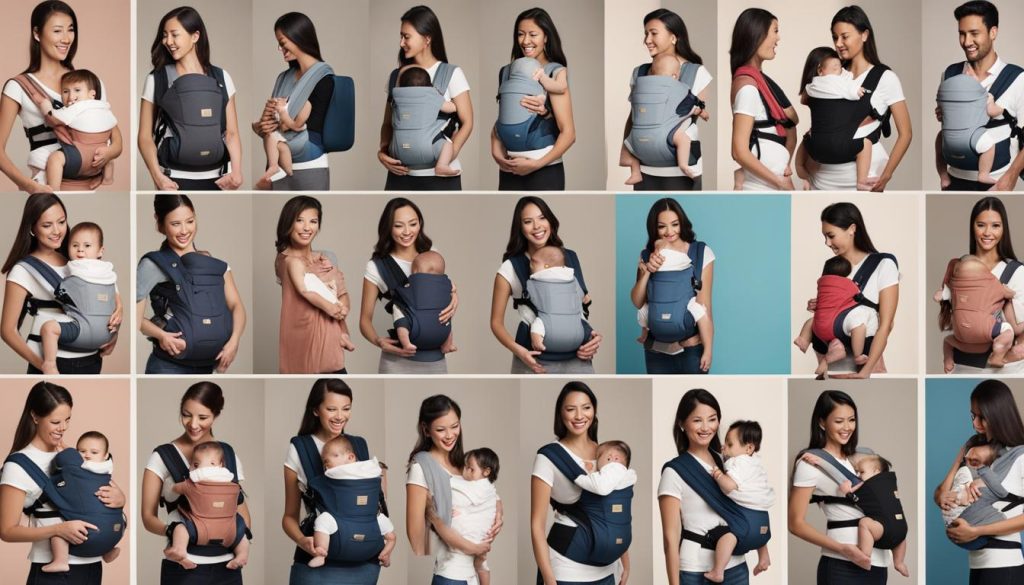Choosing the right baby carrier for a toddler can be a challenge. As toddlers are heavier and have their own preferences, it’s important to find a carrier that offers comfort and security. In this article, I will explore the benefits of baby carriers for toddlers, the different types available (wraps, slings, structured carriers), safety features, and tips for proper usage. I will also provide a curated selection of the best baby carriers for toddlers based on expert recommendations and reviews from parents.
When it comes to carrying your toddler, comfort and security are key. Whether you’re heading out for a family adventure or simply running errands, a quality baby carrier can make a world of difference. With the right carrier, you can keep your little one close while having your hands free for other tasks.
But with so many options available, how do you choose the best baby carrier for your toddler? That’s where I come in. In this article, I’ll guide you through the different types of carriers, highlighting their features and benefits. I’ll also share important safety considerations and tips for proper usage.
Whether you’re looking for a wrap, sling, or structured carrier, I’ll help you find the perfect fit for your toddler and your lifestyle. From top-rated options to ergonomic designs, you’ll discover a range of comfortable and secure baby carriers to choose from.
Why Baby Carriers are Essential for Toddlers
Baby carriers offer numerous benefits for toddlers. They promote parent-child bonding by keeping the child close and providing a sense of security. Carriers also offer convenience and mobility, allowing parents to navigate crowded places such as airports, trains, and attractions more easily. They are especially useful in places where strollers are not allowed or on uneven terrains where a stroller would be impractical. Baby carriers provide a hands-free experience, enabling parents to attend to other tasks while keeping their toddler close.
When using a baby carrier, parents can maintain eye contact with their child, engage in conversation, or simply enjoy the closeness and connection. This close physical contact not only strengthens the bond between parent and child but also provides a soothing environment for the toddler, promoting a sense of comfort and security.
“Using a baby carrier can be a game-changer for parents, allowing them to keep their hands free while providing a nurturing and comforting environment for their child.”
In addition to the emotional benefits, baby carriers also offer practical advantages. They allow parents to move more freely and comfortably, whether it’s running errands, going for walks, or traveling to new places. With a baby carrier, parents have the flexibility to explore their surroundings without the limitations of a stroller. This increased mobility can make daily tasks and outings much easier and more enjoyable for both parent and child.
Furthermore, baby carriers are designed with the comfort of both the parent and the child in mind. They distribute the weight evenly across the parent’s body, reducing strain on the back, shoulders, and arms. Many carriers also feature adjustable straps and padded support to ensure a customized and comfortable fit. With proper positioning, baby carriers provide ergonomic support for the child, promoting healthy hip and spine development.
In conclusion, baby carriers are essential for toddlers as they offer numerous benefits for both parent and child. They facilitate parent-child bonding, provide convenience and mobility, and ensure comfort for both parties. Investing in a high-quality baby carrier can greatly enhance the parenting experience and create lasting memories of closeness and togetherness.
Types of Baby Carriers for Toddlers
When it comes to choosing a baby carrier for your toddler, there are several types available to suit your needs and preferences. Each type offers unique features and benefits, providing different levels of comfort and support for both the parent and the child.
Wraps
Wraps are long pieces of fabric that can be wrapped around the parent’s body in various ways to create a snug hold for the child. This type of carrier offers excellent flexibility and adjustability, allowing for a custom fit and optimal weight distribution. Wraps are suitable for newborns and toddlers alike, but they require a bit of practice to master the wrapping techniques.
Slings
Slings are similar to wraps in that they use fabric to create a secure hold for the child. However, slings are usually made of a single piece of fabric that loops over one shoulder and across the torso. They offer a quick and easy way to carry a toddler, as they require minimal adjustments. Slings are great for shorter trips or situations where the child may need to be quickly taken in and out of the carrier.
Structured Carriers
Structured carriers, also known as soft structured carriers, are the most popular type of baby carrier for toddlers. They have a more structured design with buckles and straps, offering a convenient and comfortable way to carry a toddler for extended periods. These carriers typically have padded shoulder straps and waistbands, providing excellent support for both the parent and the child. Structured carriers are easy to put on and adjust, making them a favorite among parents.
Framed Carriers
Framed carriers are designed for outdoor activities and hiking. They feature a metal frame that provides added support and stability, making them suitable for more adventurous outings. Framed carriers usually have a larger storage capacity and additional features like sunshades or rain covers. While they may not be as compact or as easy to use as other types, framed carriers are a great choice for parents who enjoy hiking or exploring with their toddler.
| Carrier Type | Pros | Cons |
|---|---|---|
| Wraps | Excellent adjustability, custom fit, suitable for newborns and toddlers | Requires practice to master wrapping techniques |
| Slings | Quick and easy to use, minimal adjustments needed | May not offer as much support for extended periods |
| Structured Carriers | Convenient, comfortable, easy to put on and adjust | May be bulkier compared to wraps and slings |
| Framed Carriers | Provides additional support and stability, suitable for outdoor activities | Less compact and may require more storage space |
Safety Features of Baby Carriers for Toddlers
When it comes to baby carriers for toddlers, safety is of utmost importance. Parents need to ensure that the carrier they choose has the necessary safety features to keep their child secure and comfortable. Here are some key safety features to look for:
Secure Buckles and Straps
One of the most important safety features in a baby carrier is secure buckles and straps. These should be sturdy and able to withstand the weight of a growing toddler. Look for carriers that have adjustable and reinforced buckles and straps to ensure a secure fit.
Proper Weight Distribution
Proper weight distribution is essential for both the parent and the child’s comfort. The carrier should evenly distribute the weight of the toddler, preventing strain or discomfort. Features like a wide waistband and padded shoulder straps can help achieve proper weight distribution.
Adjustable Straps
Another important safety feature is adjustable straps. These allow the carrier to be customized to fit both the parent and the toddler comfortably. Adjustable straps ensure a proper fit and provide the necessary support for the child’s body as they grow.
By choosing a baby carrier with these safety features, parents can have peace of mind knowing that their toddler is secure and comfortable during outings and adventures. It is also important to carefully read the manufacturer’s instructions and guidelines for proper usage and safety precautions.
Table: Comparison of Safety Features in Baby Carriers
| Safety Feature | Description |
|---|---|
| Secure Buckles and Straps | Sturdy and adjustable buckles and straps that can withstand the weight of a growing toddler. |
| Proper Weight Distribution | Evenly distributes the weight of the toddler to prevent strain or discomfort. |
| Adjustable Straps | Allows the carrier to be customized for a proper fit and support as the child grows. |
By considering these safety features and choosing a reputable brand, parents can ensure that their baby carrier provides a secure and comfortable experience for both the parent and the toddler. Remember to always prioritize safety when using a baby carrier and follow the manufacturer’s guidelines for proper usage.
Comfort for Baby and Parent
When it comes to choosing a baby carrier for your toddler, comfort is key for both the baby and the parent. The design of the carrier should prioritize the baby’s comfort by offering an ergonomic position that supports their natural posture. Look for carriers that provide padded support in the shoulder straps and waistband, as this helps distribute the weight evenly and prevents discomfort. Additionally, opting for carriers made from breathable fabric ensures that the baby stays cool and avoids overheating during use.
Parents also need to consider their own comfort when selecting a baby carrier. Look for carriers that offer lumbar support, as this helps alleviate strain on the back and provides additional comfort during extended periods of use. Adjustable straps are another important feature to look for, as they allow for a customized fit that suits the parent’s body shape and size. By prioritizing the comfort of both the baby and the parent, you can ensure an enjoyable babywearing experience.
| Features | Benefits |
|---|---|
| Ergonomic design | Supports baby’s natural posture |
| Padded support | Distributes weight evenly and prevents discomfort |
| Breathable fabric | Keeps baby cool and prevents overheating |
| Lumbar support | Alleviates strain on the parent’s back |
| Adjustable straps | Provides a customized fit for the parent |
By considering these comfort features in a baby carrier, you can ensure that both you and your toddler can enjoy the benefits of babywearing without discomfort or strain.
Proper Usage and Ergonomics
When it comes to using a baby carrier, proper usage and ergonomics are essential to ensure the safety and comfort of both the parent and the child. By following a few guidelines, you can optimize the experience and promote healthy development for your toddler.
Ergonomic Positioning
One of the key aspects of using a baby carrier is to ensure ergonomic positioning. This means that the baby’s hips and spine are aligned in a natural and healthy way. To achieve this, it’s important to choose a carrier that supports the “M” shape position, where the baby’s legs are spread apart and their knees are higher than their bottom. This posture helps to promote optimal hip development and prevents any hip dysplasia issues.
Proper Alignment
When securing your toddler in the carrier, make sure that their back is well supported and their weight is evenly distributed. Check that their chin is off their chest, allowing for easy breathing, and that their airways are clear. It’s important to regularly monitor your baby’s position and make any adjustments necessary to maintain proper alignment throughout your babywearing experience.
Regular Breaks and Changes in Carrying Positions
It’s recommended to take regular breaks and change your carrying positions to avoid fatigue and discomfort for both you and your toddler. Experiment with different positions such as front carry, back carry, and hip carry to find what works best for you and your child. By switching positions, you can also promote healthy weight distribution and prevent any undue pressure on specific areas of your body.
By following these guidelines for proper usage and ergonomics, you can ensure a safe and comfortable babywearing experience for both you and your toddler. Remember to always refer to the manufacturer’s instructions for your specific carrier and consult with a healthcare professional if you have any concerns or questions about using a carrier.
Tips for Safety and Comfort During Babywearing
When it comes to babywearing, safety and comfort are of utmost importance. Here are some essential tips to ensure a secure and comfortable experience for both you and your little one:
Check for Proper Positioning
Before you start using a baby carrier, always make sure that your child is positioned correctly. Their airways should be clear, with their chin off their chest to allow for proper breathing. Take the time to adjust the straps and buckles to achieve a snug fit that supports your toddler’s body while maintaining their comfort.
Monitor Baby’s Breathing
While babywearing, it’s crucial to keep a close eye on your child’s breathing. Ensure that their nose and mouth are not obstructed and that they have enough room to move and breathe comfortably. Regularly check on your little one’s well-being and be mindful of any signs of discomfort or distress.
Avoid Over-Tightening
When securing the baby carrier, be careful not to over-tighten the straps. Over-tightening can restrict your child’s movement and circulation, leading to discomfort and potential health risks. Remember that a snug fit is sufficient to keep your toddler safe and supported without causing unnecessary pressure on their body.
Stay Hydrated
Babywearing can be physically demanding, so it’s important to stay hydrated. Whether you’re carrying your child for a short trip or an extended period, don’t forget to drink plenty of water. Keeping yourself hydrated helps maintain your energy levels and ensures that you can provide the best care for your little one.
By following these safety tips, you can enjoy the benefits of babywearing while ensuring the comfort and well-being of your toddler. Remember, every child is unique, and it’s crucial to choose a carrier that suits their individual needs and preferences. Prioritize safety, maintain proper positioning, and stay attentive to your child’s cues for a positive and enjoyable babywearing experience.
| Tips for Safety and Comfort During Babywearing |
|---|
| Check for Proper Positioning |
| Monitor Baby’s Breathing |
| Avoid Over-Tightening |
| Stay Hydrated |
Recommended Baby Carriers for Toddlers
When it comes to choosing the best baby carrier for your toddler, there are several top-rated options that have been parent-approved for their comfort, safety features, and versatility. Whether you’re looking for a carrier for travel, hiking, or everyday use, these recommended carriers are worth considering.
Structured Carriers
Structured carriers are a popular choice among parents for their ease of use and excellent support. They typically have padded shoulder straps and waistbands for added comfort and adjustable straps for a customized fit. Some recommended structured carriers for toddlers include:
| Carrier | Features | Price |
|---|---|---|
| Ergobaby Omni 360 | Multiple carrying positions, lumbar support, suitable from newborn to toddler | $ |
| Tula Explore | Adjustable seat width, multiple carrying positions, padded shoulder straps | $$ |
| LILLEbaby Complete | Multiple carrying positions, lumbar support, breathable mesh fabric | $$$ |
Wrap Carriers
Wrap carriers provide a snug and secure hold for your toddler. They are made from long pieces of fabric that you can wrap around yourself and your child. Here are some recommended wrap carriers:
- Moby Wrap Evolution
- Bobag Wrap
- Baby K’tan Original
Ring Slings
Ring slings are another popular option for toddler-wearing. They consist of a long piece of fabric with rings that allow for easy adjustment and quick positioning. Here are a few recommended ring slings:
- Wildbird Ring Sling
- Sakura Bloom Ring Sling
- Maya Wrap Ring Sling
Remember, the best baby carrier for your toddler will ultimately depend on your personal preferences and needs. Consider factors such as your child’s weight, the level of support and comfort you desire, and the activities you plan on using the carrier for. Reading reviews, trying on carriers if possible, and consulting with other parents can also provide valuable insights to help you make an informed decision.
Maintenance and Care of Baby Carriers
Proper maintenance and care are essential to prolong the lifespan of a baby carrier. By following a few simple steps, you can ensure that your carrier remains clean, safe, and in excellent condition for years to come.
Cleaning Baby Carriers
When it comes to cleaning your baby carrier, it’s important to check the manufacturer’s instructions for specific cleaning guidelines. Some carriers are machine washable, while others may require spot cleaning or wiping with a damp cloth. Regardless of the cleaning method, always ensure that the carrier is completely dry before storing it.
If your baby carrier is machine washable, use a gentle cycle with mild detergent. Place the carrier in a laundry bag or pillowcase to protect it from becoming tangled or damaged. Avoid using harsh chemicals or bleach, as they may weaken the fabric and compromise the carrier’s integrity.
Wipe Clean Carriers
For carriers that are wipe clean only, such as those made of leather or waterproof fabric, use a soft cloth or sponge dampened with mild soap and water. Gently wipe the carrier, focusing on any stains or spills. Rinse the cloth or sponge and wipe the carrier again to remove any soap residue. Allow the carrier to air dry completely before use or storage.
Regular Maintenance
In addition to regular cleaning, it’s important to inspect your baby carrier for any signs of wear or damage. Check the buckles, straps, and stitching to ensure they are secure and in good condition. If you notice any loose threads, frayed edges, or broken hardware, discontinue use and contact the manufacturer for repair or replacement options.
Proper storage is also key to maintaining the quality of your baby carrier. Store it in a clean and dry place when not in use, away from direct sunlight or extreme temperatures. Avoid folding or compressing the carrier in a way that may cause creases or distort its shape.
By following these maintenance and care practices, you can ensure that your baby carrier remains safe, clean, and comfortable for your little one. Regular cleaning and inspections will not only extend the life of the carrier but also provide you with peace of mind as you carry your toddler on your everyday adventures.
Conclusion and Final Thoughts
Baby carriers for toddlers offer a convenient and secure way to keep your child close while providing comfort and mobility. Whether for travel, hiking, or everyday use, choosing the right carrier is crucial for parent-child bonding and ensuring a positive experience for both.
Comfort and safety are of utmost importance when selecting a baby carrier. It’s essential to consider the different types of carriers available, including wraps, slings, and structured carriers, and choose one that best suits your needs and preferences. Look for carriers with ergonomic designs, padded support, and adjustable straps to ensure maximum comfort for both the baby and the parent.
When using a baby carrier, it’s important to follow proper usage and ergonomics guidelines. Positioning the baby in an M-shaped position with their hips and spine aligned promotes healthy development. Regular breaks and changes in carrying positions prevent fatigue and enhance comfort.
Remember to prioritize safety and comfort during babywearing. Check for proper positioning, monitor the baby’s breathing, and avoid over-tightening the carrier. Staying hydrated is also essential for both the parent and the baby.
In conclusion, baby carriers for toddlers provide a practical solution for keeping your child close while ensuring their comfort and safety. By choosing the right carrier and following proper guidelines, you can enjoy the benefits of babywearing and create a stronger bond with your little one.
References and Additional Resources
When it comes to choosing the right baby carrier for your toddler, it’s always helpful to have access to expert recommendations, parent reviews, and manufacturer’s instructions. Here are some valuable resources to further assist you in your decision-making process:
1. Expert Recommendations:
Seek advice from babywearing experts who have extensive knowledge and experience in evaluating and recommending the best baby carriers for toddlers. You can find expert recommendations from renowned babywearing organizations, such as the Baby Carrier Industry Alliance (BCIA) or the Babywearing International.
2. Parent Reviews:
Reading reviews from other parents who have already tried and tested different baby carriers can provide valuable insights. Websites like Amazon, BuyBuyBaby, and Target offer customer reviews and ratings that can help you gauge the quality, comfort, and durability of various baby carriers.
3. Manufacturer’s Instructions:
Always refer to the manufacturer’s instructions that come with your chosen baby carrier. These instructions will provide specific guidelines on how to properly use, adjust, and maintain your carrier, ensuring the safety and well-being of your toddler. Manufacturer websites and customer service helplines are also valuable resources for additional support and information.
By utilizing these resources, you can make an informed decision and select the best baby carrier that meets your needs, preferences, and most importantly, ensures the comfort and safety of your toddler.





